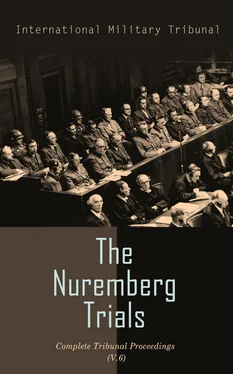On Pages 77 to 80 of my written statement I had thought it necessary to make a summary of these charts, but I consider it is not possible to read even the summary because the figures are too numerous.
According to information provided by the French administration, of that sum the Germans settled, by way of occupation costs and clearing, only 59,254,639,000 francs, leaving the difference of 19,506,109,000 francs charged to the French Treasury.
The percentage of the German levies in relation to the whole French production can be summarized in a chart which I have given in my brief and I ask the Tribunal for permission to read it:
“The percentage of levies of raw materials in relation to French production: Coal, 29 percent; electric power, 22 percent; petroleum and motor fuel, 80 percent; iron ore, 74 percent; steel products, crude and half finished, 51 percent; copper, 75 percent; lead, 43 percent; zinc, 38 percent; tin, 67 percent; nickel, 64 percent; mercury, 50 percent; platinum, 76 percent; bauxite, 40 percent; aluminum, 75 percent; magnesium, 100 percent; sulphur carbonate, 80 percent; industrial soap, 67 percent; vegetable oil, 40 percent; carbosol, 100 percent; rubber, 38 percent; paper and cardboard, 16 percent; wool, 59 percent; cotton, 53 percent; flax, 65 percent; leather, 67 percent; cement, 55 percent; lime, 20 percent; acetone, 21 percent.”
This enumeration permits us to consider that officially about three-quarters of the raw materials were seized by the occupying power, but these statistics must be qualified in two ways: A large part of the quota of raw materials theoretically left to the French economy was in fact reserved for priority industries, that is to say, those industries whose production was reserved for the occupying power. Secondly, these requisitions and percentages include only the figures of official deliveries; but we have seen that the Germans acquired considerable quantities of raw materials from the black market, especially precious metals: gold, platinum, silver, radium, or rare metals, such as mercury, nickel, tin and copper.
In fact, one can say in general that the raw materials which were left for the needs of the population were insignificant.
Now, I come to Section 3: Levies of manufactured goods and products of the mining industry.
As I had the honor to point out to you in my general remarks, the Germans, using divers means of pressure, succeeded in utilizing directly or indirectly the greater part of the French industrial production. I shall not go over these facts again and I shall immediately pass to a summary of the products which were delivered. I submit as Document Number RF-248 a chart which contains statistical data, according to industries, of levies by the occupying power of manufactured goods during the course of the occupation.
I do not want to tax the patience of the Tribunal by reading this; I shall simply cite the summary of this chart, which is as follows: Orders for products finished and invoiced from 25 June 1940 until the liberation—Mechanical and electrical industries, 59,455 million; chemical industry, 11,744 million; textiles and leather, 15,802 million; building and construction material, 56,256 million; mines (coal, aluminum, and phosphates), 4,160 million; iron industry, 4,474 million; motor fuel, 568 million; naval construction, 6,104 million; aeronautical construction, 23,620 million; miscellaneous industries, 2,457 million; making a total of 184,640 million.
These statistics should be commented upon as follows:
1) The information which is contained here does not include the production of the very industrialized departments of Nord and of Pas de Calais, attached to the German administration of Brussels, nor does it include the manufactures of the Haut-Rhin, Bas-Rhin, and Moselle departments, actually incorporated into the Reich.
2) Out of the total sum of 184,640 million francs worth of supplies, the information which we have to date does not as yet permit us to fix the amount regulated by the Germans by way of either occupation costs or clearing, or the balance which was not made the subject of any settlement.
3) If, on the basis of contracts, one made an estimate of the industrial production levied by Germany in the departments of Nord and Pas de Calais, one would obtain a figure for those two departments of 18,500 million, which would bring the approximate total up to more than 200,000 million francs.
The extent of the German levies on manufactured products is summarized in the following chart which I submit to the Tribunal, and which I have summarized on Page 87 of my written statement. I shall take the liberty of reading it once more to the Tribunal. It will show the proportion of the manufactured goods which the French population was deprived of: Automobile construction, 70 percent; electrical and radio construction, 45 percent; industrial precision parts, 100 percent; heavy castings, 100 percent; foundries, 46 percent; chemical industries, 34 percent; rubber industry, 60 percent; paint and varnish, 60 percent; perfume, 33 percent; wool industry, 28 percent; cotton weaving, 15 percent; flax and cotton weaving, 12 percent; industrial hides, 20 percent; buildings and public works, 75 percent; woodwork and furniture, 50 percent; lime and cement, 68 percent; naval construction, 79 percent; aeronautic construction, 90 percent.
The scrutiny of this chart leads to the following remarks:
The proportion of entirely finished products is very large, for instance: automobiles, 70 percent; precision instruments, 100 percent; heavy castings, 100 percent; whereas, the proportion of the products in the process of manufacture is not as great, for example: foundry, 46 percent; chemical industry, 34 percent; et cetera.
This state of affairs results from the fact that the Germans directed the products in the process of manufacture—in theory reserved for the French population—into finishing industries which had priority, that is to say, whose production was reserved for them.
Finally, through their purchases on the black market, the Germans procured an enormous quantity of textiles, machine tools, leather, perfumes, and so forth. The French population was almost completely deprived of textiles, in particular, during the occupation. That is also the case as regards leather.
Now, I reach Section 4: the removal of industrial tools.
I shall not impose on your time. This question has already been treated as far as the other occupied countries are concerned. I would merely point out that in France it was the subject of statistical estimates which I submit to you as Document Number RF-251. These statistical estimates show that the value of the material which was removed from the various French factories, either private or public enterprise, exceeds the sum of 9,000 million francs.
It was observed that for many of the machines which were removed, the Germans merely indicated the inventory values after reduction for depreciation and not the replacement value of the machines.
I now come to Section 5: Securities and Foreign Investments. In Document EC-57, which I submitted as Exhibit Number RF-105 at the beginning of my presentation, I had indicated that the Defendant Göring himself had informed you of the aims of the German economic policy and he ventured to say that the extension of German influence over foreign enterprises was one of the purposes of German economic policy.
These directives were to be expressed much more precisely in the document of the 12th of August 1940, which I submit as Exhibit Number RF-252 (Document Number EC-40), from which I shall read a short extract:
“Since”—as the document says—“the principal economic enterprises are in the form of stock companies, it is first of all indispensable to secure the ownership of securities in France.”
Читать дальше












